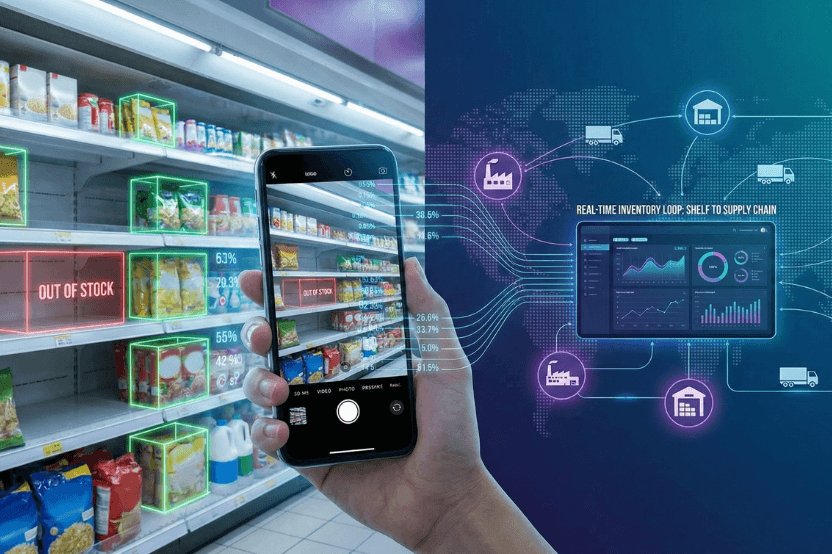For years, CPG brands have faced a choice: build a custom solution or buy a "one-stop-shop" package. But in a fast-changing market, this isn't the full picture. The real choice today is between a closed, pre-packaged solution and a flexible, integrated Visual AI infrastructure.
One model offers simplicity, but limits your potential. The other offers full control, but requires a strategic shift.
Let's break down the pros and cons of each.
The Rise of a New Choice: Packaged Solutions vs. Visual AI Infrastructure
As CPGs increasingly adopt Image Recognition (IR) to automate their retail execution, two distinct paths have emerged.
- Packaged IR Solutions: These are often presented as turnkey, "closed solutions." They are a pre-built product with a fixed set of features and limited flexibility.
- Visual AI Infrastructure (IR-as-a-Service): This is a modular, API-native model where IR is treated as an infrastructure layer within your existing tech stack.
The choice between them has a direct impact on your team's agility, scalability and long-term ROI.
The Pros & Cons of a Packaged IR Solution
Pros: Quick Wins and Simplicity
- Packaged IR solutions have a straightforward value proposition: they're fast to deploy and simple to use. This "one-stop-shop" approach can provide quick wins for teams testing the technology. They offer a simple way to start with automated shelf audits, Out-of-Stock (OOS) detection and compliance alerts.
Cons: Siloed Data and Limited Flexibility
The simplicity of packaged solutions comes with significant trade-offs.
- Low Integration: These systems often operate in a silo, with low integration with your core enterprise systems like your SFA, ERP or CRM. This can create more manual work and a fragmented view of your data.
- Limited Customisation: Because they are designed for a wide audience, these solutions offer minimal customisation. They are bound by the vendor's roadmap and can't be adapted to your unique use cases or processes.
- Vendor-Owned Innovation: In this model, the vendor owns the innovation. Your business is reliant on their release cycles and development priorities, making it challenging to evolve as your needs change.
- No Access to Raw Data: Packaged solutions typically keep raw image data, models and recognition logic locked inside the vendor’s platform. Without access, you can’t validate results independently, run your own analytics or feed insights into other AI initiatives. This limits your ability to innovate, experiment or build a competitive advantage on top of the data your business is generating.
The Pros & Cons of an Integrated Visual AI Infrastructure
Pros: Full Ownership and Strategic Scalability
Visual AI as an infrastructure layer is designed to be the backbone of your CPG tech stack. This model, which we call IR-as-a-Service, is like a box of Lego blocks, each component can evolve independently while still working together seamlessly. This is a key part of building a future-proof CPG tech stack.
- High Flexibility: An API-native approach allows you to plug the IR engine into any tech stack, whether it’s in-house or a third-party platform. This gives you full control over how IR connects with your CRM, product catalogues or AI engines.
- Customisation: This model allows for high customisation, allowing you to build the exact solution your business needs. That flexibility unlocks a wide range of use cases, from automated shelf audits to trade ROI attribution. The foundation is one, but the applications are many. See examples in our blog: The Four Strategic Levers of Retail Execution.
- Joint Ownership of Innovation: With an infrastructure approach, you and your technology partner co-own the innovation. The platform provides the high-accuracy engine and you gain the flexibility and control to embed it deeply within your ecosystem.
- Full Data Ownership: Unlike packaged solutions, an infrastructure approach gives you direct access to raw image data, models and recognition outputs. This means you can validate results independently, run your own analytics and feed insights into other AI initiatives. It ensures full control, flexibility and the ability to innovate on top of your own data.
Cons: Strategic Investment Required
- While the long-term benefits are clear, adopting an infrastructure approach requires a strategic mindset. It may require additional change management to align internal teams and processes. However, this upfront investment ensures you're building a future-proof system that can adapt and scale with your business for years to come. This is a critical step in moving beyond the quick wins to strategic gains of retail execution.
Your Technology Partner, Not Another Solution
The goal of modern retail execution is not just to collect data, but to turn it into a competitive advantage. This requires a shift from buying a packaged solution to building a unified, intelligent infrastructure. This is also where an ontology plays a crucial role.
By choosing a technology partner that provides a flexible Visual AI infrastructure, you can turn a single image into a data point that feeds audits, guides field reps, triggers replenishment and validates trade ROI. This is what makes IR truly scalable and transformative. You can read how this drives real-world business impact in our blog on POS displays.
At Neurolabs, our approach is built on synthetic image recognition technology. By creating digital twins of products, we deliver scalable, accurate recognition instantly powering audits, field insights and ROI measurement. This foundation ensures you get more reliable data, faster deployments and a future-proof system that adapts with your business.
If you are ready to move beyond the buzzwords and see how a fully integrated, AI-driven infrastructure can power your retail execution, please request a demo.




